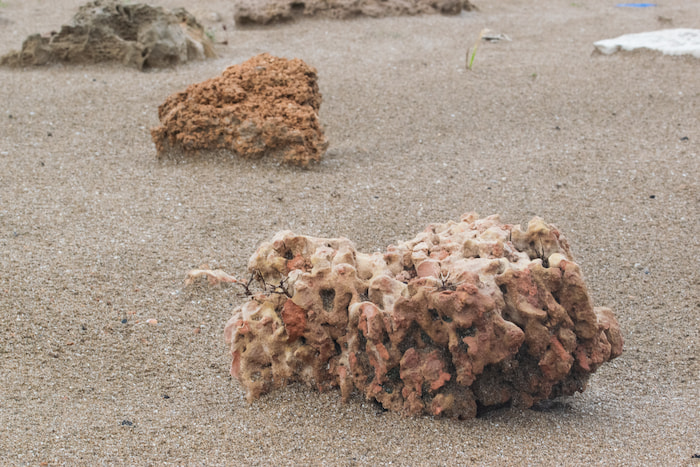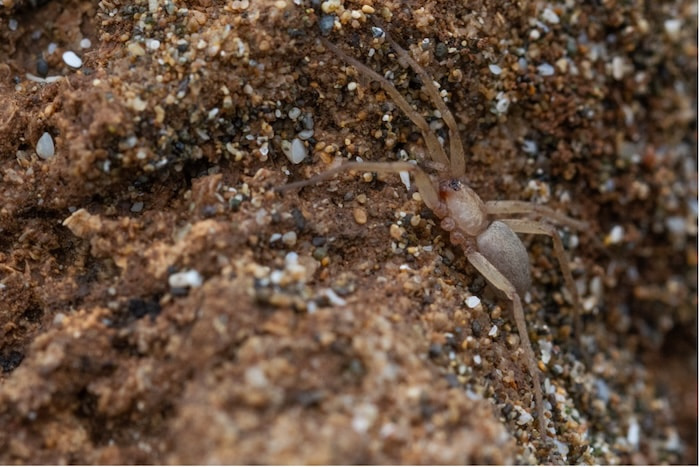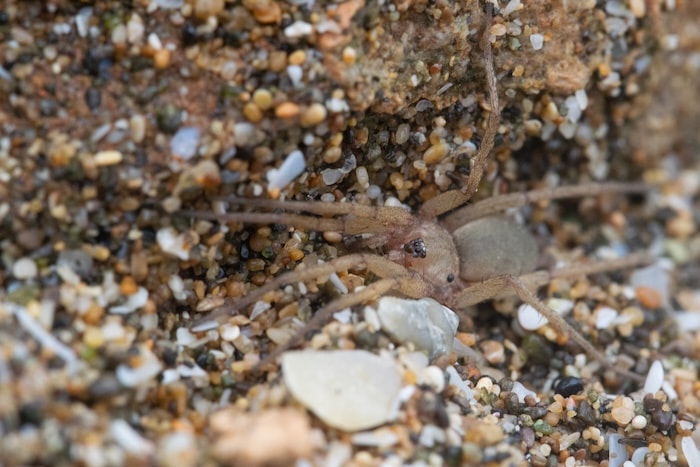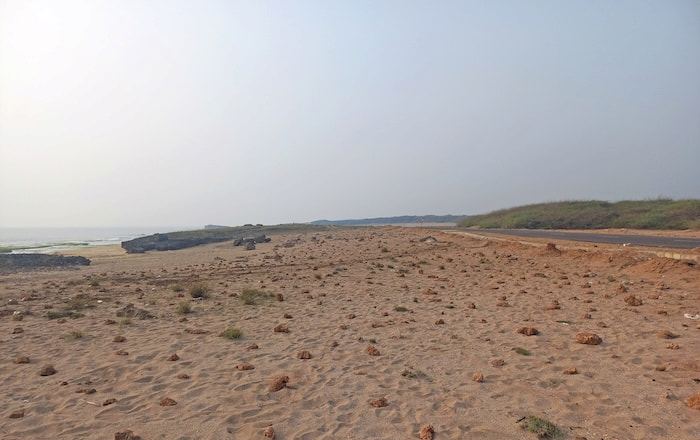Monsoons had already arrived on the western coast when I reached Sonam Bandharo. The sea was raging, splashing furiously against the rocky coast. The dark asphalt road connecting the coast to Velan's nearest village shimmered under the glorious weather. It was, however, the sand beds that the road cut through that made me ride through the draft and rain. Under the rugged rocks lay my subject of interest – a burrowing spider.
Identified after a long time from the Indian sub-continent, the Pterotricha strandi has been inhabiting this small stretch of sandy soil on Velan’s coast. Inconspicuous, measuring just a couple of centimetres, it was just one male specimen of the spider that was recorded back in 1983 from Dwarka, Gujarat. Since then, the spider might as well have been thought to be locally extinct until a biodiversity survey revealed its presence in Sonam Bandharo, Velan, Gujarat, in 2023. However, along with this revelation came a unique challenge.
The Asphalt Threat: Road Construction and Spider Habitat Destruction
A nocturnal creature, the Pterotricha strandi hides from the daylight and its winged predators by burrowing under the sandy soil and seeking protection under the rocky shelter overhead. It nestles in the small perforations of volcanic rocks that are quite common in this part of the world. Being a solitary hunter, each individual needs its own rock to burrow under. When the road construction started back in 2022, a majority of these rocks were removed to make way for a smoother bed for the asphalt to be laid. Inadvertently, the colony, which was already restricted, was destroyed. Unknowingly, we were wiping out a species that had somehow survived the tests of time.

The small volcanic rocks form the recluse of the Pterotricha strandi. Each rock supports just a single individual of the species | Photograph by Madhumay Mallik
Dhruv Prajapati, an arachnologist with more than eight years of experience in the field, who first identified the spider from Sonam Bandharo, now sought a solution. With a Rapid Action Project (RAP) grant from the Wildlife Trust of India, Dhruv teamed with the locals to limit, even reverse, the damage that has already been done. More than 500 rocks and stones, similar in shape, surface texture and colour, were collected from other areas to supplement the reduced cover in the 1.5 hectares of land that was identified as the habitat. The villagers contributed by placing the rocks strategically across the known habitat to allow the spiders to take shelter. “Juveniles, which wouldn’t otherwise have found a roof above and perished, now have their own rocks!” exclaims Dhruv as he joins me to explore the progress of the intervention.
A Glimpse into the World of the Pterotricha Strandi
As we go on to examine, overturning a few rocks, Dhruv excitedly points out to the little reddish-brown spiders. Mostly, juveniles, no larger than a centimetre, promptly run in a frenzy on being exposed to the elements. We immediately put the rocks back in their original position. However, it was difficult to get a closer look until one of them settled itself for at least a few seconds. Finally, on probably our third or fourth attempt, we found an adult individual much calmer amidst the sudden commotion in its life. Tightly perched in its perforated rocky housing, we turned it to face the leeward side. The bigger rock also ensured that the wind’s intensity was minimised. Finally, I was able to focus my Tamron 90mm Macro lens past the shake and onto the individual.

The Pterotricha strandi can grow back lost legs. In some cases, the spider will itself consume injured appendages for new ones to grow back | Photograph by Madhumay Mallik
The Pterotricha strandi belongs to the Gnaphosidae family or the ground-dwelling spiders, with more than 2000 species that have been described across the world, and about 150 of them occur in India. It’s also the sixth largest family of spiders, characterised by prominent spinnerets. These spiders don’t make a web, as is generally associated with most spider species. Rather, they are more like the jumping spiders who hunt on the surface by running down their prey. For the Pterotricha strandi, crickets, isopods, and beach flies are included. Eight eyes, paired in two rows at the front of the body, they are expert hunters at night. The thin hairs along its body further help the spider to sense prey nearby and launch a wrapping attack. These spiders are also cannibalistic, and it is only during mating that two of their kind are found together. The female will carry and care for the egg sack until the spiderlings hatch and scatter along to find rocks of their own.

An adult individual can grow up to one inch in body length | Photograph by Madhumay Mallik
Velan’s Pride: Protecting a Spider Found Nowhere Else
It’s interesting how much goes on under the rocks and the lives of these tiny creatures. Though they play an important role in the desert ecosystem, spiders are not the first animals one would think about when talking about biodiversity protection. Consequently, it did surprise me when the locals of Velan showed such understanding and care for a species they didn’t know existed till about a year ago. “When I came to know that our beaches host a unique spider, the only habitat in the country, it made me feel special”, says Veerabhai, a local we met at the beach. Veerabhai has been a part of the awareness workshops that Dhruv and his team at Web of Nature (WON) have been conducting. Since the discovery, locals have been conducting beach cleaning drives and are trying their best to ensure that the habitat is not damaged and that no more rocks are picked up or displaced. “We also don’t want a signage to be placed here because it will only attract unwanted curiosity from visitors”, adds Veerabhai.

The microhabitat of the Pterotricha strandi in Sonam Bandharo, Velan, Gujarat are the naturally occurring volcanic rocks/stones that are scattered in the sandy landscape | Photograph by Dhruv Prajapati
The case of Pterotricha strandi highlights the several micro habitats that go unnoticed as humans continue to claim more. The spider was thriving until we didn’t know about its existence and until this road didn’t come up. Now that we have established a species and a very specific habitat, we can work towards protecting what remains. This indeed shows up in the latest survey reports. The numbers went down to less than five after the road construction took place back in 2023. More than 320 individuals were recorded in the latest survey done in May 2024. The success shows for itself but only time will tell if the intervention can sustain itself and the Pterotricha strandi can reclaim its land. “We hope that this part of the beach doesn’t go to another development project in the near future” ends Dhruv.
Join the movement to protect rare species like the Pterotricha strandi. Share this story and support conservation efforts along Gujarat’s coast.
Main image: Other than Velan, Gujarat, the Pterotricha strandi has been reported from Iran, Turkmenistan and Afghanistan | Photograph by Madhumay Mallik - Nikon DSLR
Madhumay posts on Instagram as smallerwonders.


